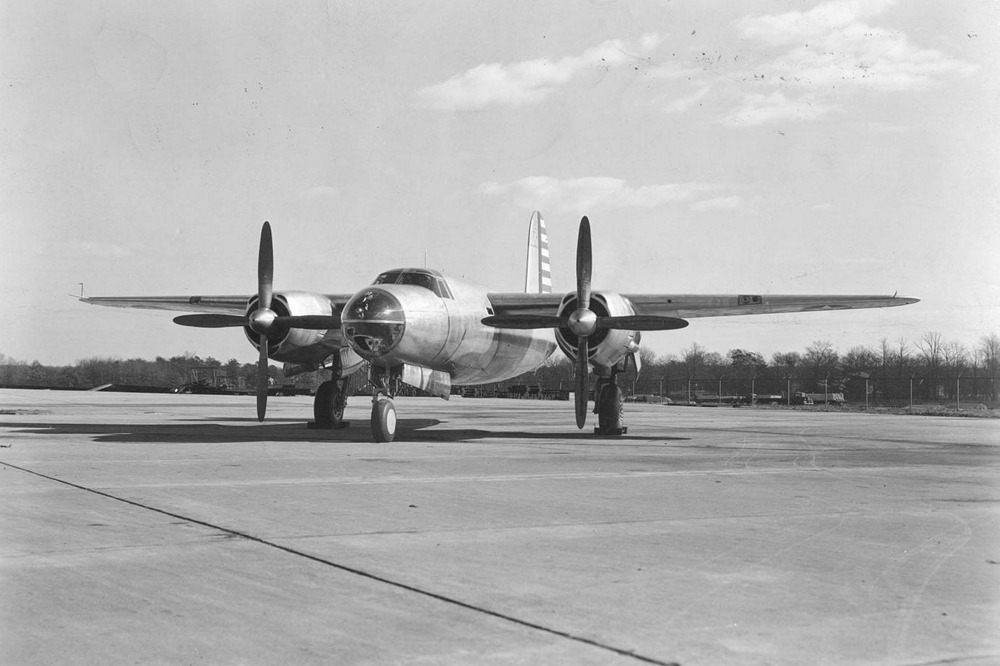History
Development of the Marauder began on March 11, 1939, when the U.S. Army Air Corps issued Proposal No. 39-640, calling for a medium bomber capable of carrying a 3,000 lb (1,400 kg) bombload over 2,000 miles (3,200 km) at a speed exceeding 300 mph (480 km/h). Martin, Douglas, Stearman, and North American all submitted designs. Martin’s entry, the Model 179, was a shoulder-wing monoplane of all-metal construction with tricycle landing gear and a single tail, differing from North American’s twin-tailed B-25 design. The fuselage was clean and cigar-shaped, designed for high aerodynamic efficiency.
The Army Air Corps selected Martin’s Model 179 on July 5, 1939, just two months before the outbreak of World War II. The initial contract, for 201 aircraft, was the largest order the Air Corps had ever placed. The aircraft was eventually and officially named the Marauder in October 1941, after being formally designated by British officials.
The B-26 was a groundbreaking design in several ways. It was the first combat aircraft to use butted seams for its skin, reducing drag and improving airflow. It was also the first to incorporate a power-operated turret: the electrically driven Martin 250CE, mounting twin .50 caliber Browning M2 machine guns. The turret design proved so successful that more than 56,000 were built and used across 27 aircraft types. The B-26 was also the first bomber with rubber self-sealing fuel tanks, an all-electric bomb release system, and four-blade Curtiss electric propellers driven by powerful 18-cylinder Pratt & Whitney R-2800-5 radial engines. Martin also pioneered the use of a full Plexiglas nose, giving better visibility than the framed noses of the B-17 and B-25.
No prototype was built; instead, the first production aircraft served as the test model. The B-26 first flew on November 25, 1940, and 201 B-26-MAs were ultimately delivered. The first four B-26-MAs were accepted on February 22, 1941; they were delivered and assigned to the 22nd Bomb Group at Langley Field, Virginia. While a handful were delivered in natural metal, most were painted in olive drab over neutral gray. Armament on early B-26-MAs installed twin .50s in the dorsal turret, a flexible .30 in the nose, a .30 in the ventral position, and another .30 in the tail.
The Marauder quickly gained a reputation as a difficult and dangerous aircraft, nicknamed the “Widow Maker.” Its unusually high landing speed of 130 mph required precise handling, and nose-gear failures caused by shifting the center of gravity. Early aircraft were returned to the factory for modifications to address these issues, and production was soon shifted to the improved B-26A.
Combat service began after Pearl Harbor. In early 1942, 51 Marauders of the 22nd BG were shipped to Hawaii, reassembled, and flown across the Pacific to Australia. 48 completed the journey, flying their first mission on April 5, 1942, against Japanese forces at Rabaul, a 2,600-mile round trip. Throughout April and May, the 22nd BG flew 16 missions against Rabaul as part of the 5th Air Force.
In the field, the 22nd BG modified its Marauders extensively. Tail glazing was removed for better fields of fire, observation windows were added, and additional .50 caliber guns were installed in the nose, waist, and tail positions, replacing the original .30s. Long-range missions saw 250-gallon auxiliary fuel tanks fitted in the rear bomb bay. These changes became standard across the group’s fleet.
By January 1943, losses and wear reduced the 22nd BG’s strength, and the group transitioned to the B-25 Mitchell. The 19th Bomb Squadron, however, retained its original Marauders through mid-1943, getting rid of the olive drab camouflage and leaving them in natural silver. Because of this, this Bomb Squadron was nicknamed “Silver Fleet.” The last mission with these veteran aircraft took place on January 9, 1944, after which the remaining planes were retired to storage in Brisbane and eventually scrapped.
The B-26-MA also saw action elsewhere. At the Battle of Midway, four Marauders, two from the 22nd BG and two from the 38th BG, conducted a daring torpedo attack on the Japanese carrier Akagi. One of them, the famous Susie Q of the 22nd BG, strafed the carrier’s deck after releasing its torpedo, narrowly missing the bridge. Although the torpedo attack failed, the Marauders shot down a Zero and inflicted fatal wounds on two sailors aboard Akagi. Two of the bombers were lost, while the others, including Susie Q, returned to Midway heavily damaged. The crew of Susie Q received Distinguished Service Crosses, and several also received Purple Hearts.
Elsewhere in the Pacific, the 38th BG operated Marauders from New Caledonia and Fiji, striking Japanese bases in the Solomons after the Battle of Midway. In one instance, a B-26 was credited with downing a Kawanishi H6K flying boat. However, by 1943, the 38th BG’s Marauders were being phased out in favor of the B-25 aircraft.
Finally, in the Aleutians, the 28th Composite Group used torpedo-armed B-26s in anti-shipping roles. Though no successful torpedo hits were recorded, they played a part in the difficult campaign against Japanese forces in the northern Pacific.








